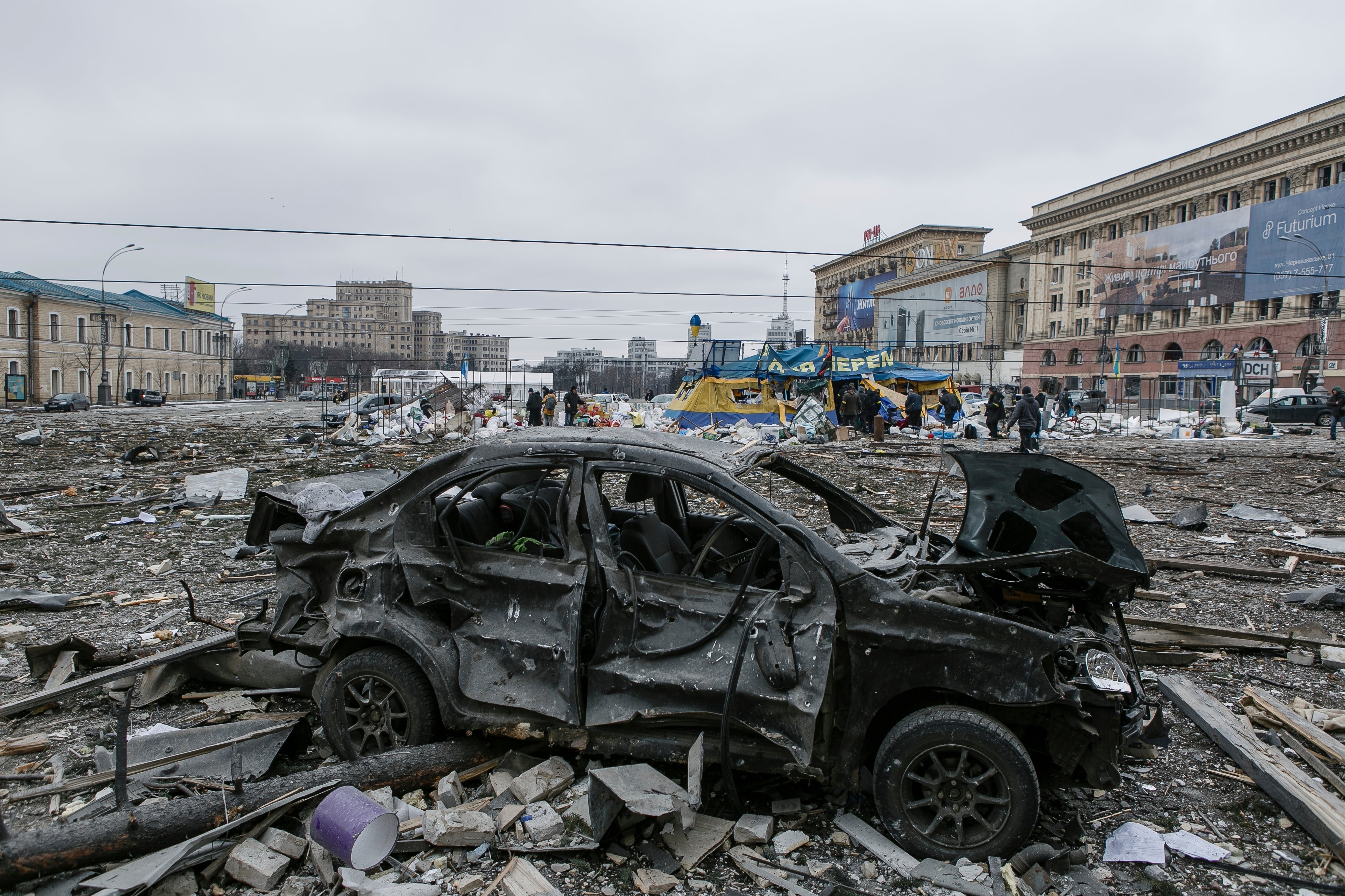This story has been updated with new information from the Pentagon and United Nations.
Ukraine armed forces have been striking that long line of Russian troops heading to Kyiv while the Russians have used thermobaric weapons against Ukrainian cities, the head of Ukraine’s defense intelligence agency tells Military Times.
“We are striking the enemy’s columns,” Brig. Gen. Kyrylo Budanov told Military Times in an exclusive interview Wednesday morning. “We burn many columns of the enemy.”
The strikes, he said, are being conducted by Ukraine Su-24 and Su-25 fighter jets, artillery and missile barrages.
“My intelligence officers and agents are directing and calling the strikes,” he said.
Marine Lt. Col. Anton Semelroth, a Pentagon spokesman said Wednesday morning he “would not speak to intel assessments.”
Speaking to reporters Wednesday afternoon on the condition of anonymity, a senior defense official said the Pentagon has indications Ukraine forces are targeting the convoy in an attempt to stymie what officials believe is Russia’s ultimate goal: to occupy Kyiv and install a puppet government. The official spoke to reporters on the condition of anonymity.
[Ukraine jets hit Russian column; Russia has used thermobarics, Ukraine military says]
“We’ve seen indications that at times and at certain places, the convoys may have been resisted by Ukrainian forces and I think I have to leave it at that,” the official said. “But we’ve seen indications that we are in no position to refute [Ukraine claims they have hit the convoy].”
RELATED

The Russian troops staged around the outside of Ukraine’s capital city appear to be in a holding pattern of some kind, a senior U.S. defense official told reporters Tuesday.
Formations that had been moving toward Kyiv are essentially in the same spot today as they were Monday, the official said, roughly 17 miles outside the city center.

“We believe that that’s for a number of reasons,” the official said. “Obviously, the resistance that they’re facing, the fuel and sustainment problems that they’re having. We are also picking up signs that they’re having problems feeding their troops, that they’re not only running out of gas, but they are running out of food.”
The Pentagon’s assessment echoes multiple reports from recent days that Russian troops are looking for fuel and sustenance as they roll toward Kyiv.
There’s also the possibility, the official said, that the Russians are taking a strategic pause to regroup, possibly after a stiffer defense than anticipated from the Ukrainian armed forces.
Budanov also told Military Times that the Russians have been using thermobaric weapons in the assault on Kharkiv and near Kyiv.
They were fired, he said, by TOS-1M weapons systems.
Thermobaric weapons produce more heat and overpressure than conventional weapons by exploding a vapor in the blast zone, according to the Journal of Military and Veterans’ Health. Such weapons create tremendous damage to the human body, according to the journal.
The Russian Embassy in Washington, D.C., did not immediately return a request seeking comment on both claims by Budanov.
Human Rights Watch condemned Russia’s reported used of the weapons a year earlier in Chechnya in 2000, according to The Guardian, as “a dangerous escalation” with “important humanitarian implications”.
The Guardian described the weapons as effective at their “specific purpose” of “primarily destroying defensive positions.” While they would not be used to penetrate a tank, they could be a “”very destructive weapon” against an apartment complex or other building.
“They are not illegal, even though their effects can be pretty horrific because of … creating a vacuum and sucking the air out of the lungs of defenders,” Marcus Hellyer, senior analyst at the Australian Strategic Policy Institute, told The Guardian.
Linda Thomas-Greenfield, the U.S. envoy to the United Nations, confirmed the Russians have used thermobaric weapons, also known as vacuum bombs.
“We have seen videos of Russian forces moving exceptionally lethal weaponry into Ukraine which has no place on the battlefield,” the U.S. envoy to the U.N., Linda Thomas-Greenfield, told the General Assembly, according to The Hill.
“That includes cluster munitions and vacuum bombs, which are banned under the Geneva Convention.”
She echoed allegations made on Monday — by Ukraine’s Ambassador to the U.S. Oksana Markarova to American lawmakers — that Russia was using in its attacks on Ukraine a thermobaric weapon, according to The Hill.
A senior U.S. defense official on Tuesday said the Pentagon has seen weapons systems that can launch themobaric weapons inside Ukraine, but could not confirm the thermobaric weapons are actually in Ukraine or their use. Semelroth on Wednesday told Military Times there was no update to that assessment. That official on Wednesday “had nothing more to add.”
Military Times Pentagon Bureau Chief Meghann Myers contributed to this report.
Howard Altman is an award-winning editor and reporter who was previously the military reporter for the Tampa Bay Times and before that the Tampa Tribune, where he covered USCENTCOM, USSOCOM and SOF writ large among many other topics.





